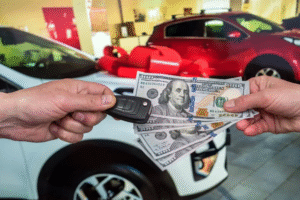
Your car is constantly communicating with you. Through a complex language of sounds, sensations, and dashboard lights, it tells you when things are running smoothly and, more importantly, when something is wrong. When it comes to safety, no system “talks” more clearly than your brakes.
Learning to interpret these signals is a crucial skill for any driver. It allows you to catch problems early, ensuring your safety and helping you avoid the costly collateral damage that comes from neglect. Here are seven telltale signs your car is sending to let you know it’s time for new brake pads.
1. The High-Pitched Squeal
This is the most common—and least urgent—warning sign. It’s a sharp, high-pitched squealing noise that occurs when you apply the brakes and usually disappears when you let go.
- What your car is telling you: This sound is intentional. Most brake pads are manufactured with a small metal tab called a “wear indicator.” When your pads have worn down to a predetermined minimum thickness, this tab makes contact with the metal rotor, creating that unmistakable squeal. It’s your car’s polite way of saying, “Hello! I’m getting low on brake pad material. Please schedule a service soon.”
2. A Deep, Harsh Grinding Noise
If the initial squeal is ignored, it will eventually be replaced by a much more alarming sound: a loud, low-pitched grinding or growling.
- What your car is telling you: This is an emergency alarm. The grinding means the friction material on the pads has been completely worn away. You are now hearing the sound of the metal brake pad backing plate grinding directly against the metal rotor. This severely reduces your stopping power and is actively damaging the rotor with every revolution of the wheel. Stop driving as soon as safely possible and have the vehicle serviced immediately.
3. A Spongy or “Mushy” Brake Pedal
You press the brake pedal, but it feels soft, sinks further to the floor than usual, and lacks its normal firm resistance.
- What your car is telling you: This “spongy” feeling indicates a problem in the hydraulic system. It could mean there is air or moisture in the brake lines, which compresses more easily than brake fluid and results in a loss of pressure. It can be a sign of old, contaminated fluid or, more seriously, a leak in a brake line or master cylinder. The message is clear: “My hydraulic system is compromised and I cannot apply full stopping force.”
4. The Car Pulls to One Side When Braking
You’re driving straight, but when you step on the brake, you feel a distinct pull on the steering wheel, trying to tug the car to the left or right.
- What your car is telling you: Your brakes are working unevenly. This imbalance means one side is clamping with more force than the other. The issue is typically on the side opposite the direction of the pull. For example, a pull to the right often means the left brake isn’t working correctly. This is a classic symptom of a seized caliper slide pin or a collapsed brake hose.
5. Vibrations or Pulsating in the Pedal
When you apply the brakes, you feel a rhythmic vibration or pulsing sensation transmitted up through the brake pedal or even the steering wheel.
- What your car is telling you: The surface of your brake rotor is no longer perfectly flat. This condition, known as a “warped” rotor, is often caused by the excessive heat generated during heavy braking or from driving with worn-out pads. As the pads press against the uneven, wavy surface of the spinning rotor, it creates the pulsing sensation you feel.
6. The Brake Warning Light Illuminates
Your dashboard suddenly lights up with a warning symbol, typically in red or yellow, that says “BRAKE” or shows an exclamation point inside a circle (!).
- What your car is telling you: This is your car’s computer giving you a direct and urgent command to pay attention. This light can signify several issues, from the simple (your parking brake is still partially engaged) to the serious (a critical drop in brake fluid pressure or an issue with the ABS system). Never ignore this light.
7. You Can See They’re Worn
Sometimes, the most reliable sign is a simple visual check.
- What your car is telling you: Look through the spokes of your wheels at the brake caliper. You should be able to see the brake pad pressed against the metal rotor. If the friction material (the part that makes contact with the rotor) appears to be extremely thin—generally less than a quarter of an inch (about 6mm)—it’s time for a replacement.
Your car gives you plenty of notice before your brakes fail. To better understand the timeline for replacement, you can learn more about how often you should change your brake pads. By listening, feeling, and looking, you can address the issue proactively, keeping you safe and your repair bills low.





